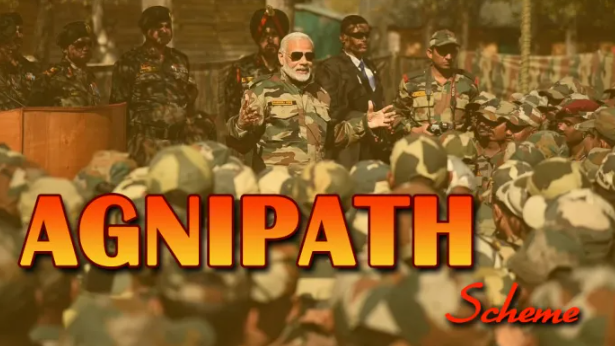Review of the Agnipath Scheme (GS Paper 3, Defence)

Context:
- The National Democratic Alliance (NDA) coalition has called for a comprehensive review of the "Agnipath" scheme, an initiative introduced in 2022 to address short-term recruitment needs within the Indian Army.
- This scheme, also known as the Tour of Duty, has sparked debates regarding its efficacy and implications for the armed forces.
Agnipath Scheme Overview:
- The Agnipath scheme offers a unique approach to recruitment by enlisting soldiers, referred to as 'Agniveers', for a short-term commitment of four years.
- At the conclusion of this tenure, only a fraction, specifically 25%, of the recruits from a batch are retained for regular service for a more extended period of 15 years.
- The scheme targets individuals aged between 17.5 years to 21 years, offering them an opportunity to serve the nation through the Armed Forces for a limited duration.
Significance of the Scheme:
- The rationale behind the Agnipath scheme stems from various strategic objectives.
- Firstly, it aims to address the imperative of reducing the average age profile within the military, particularly the Army, which has been a long-standing concern dating back to the 1980s.
- Additionally, the scheme aligns with global trends observed in modern armed forces, where short-term service contracts ranging from 2 to 8 years are prevalent.
- By adopting such a model, India seeks to ensure a youthful and tech-savvy profile within its armed forces, thereby enhancing its readiness for future conflicts characterized by advancements in technology and warfare.
- Moreover, the Agnipath scheme is seen as a response to the budgetary constraints faced by the Indian armed forces, with substantial portions of the defense budget allocated towards salary and pension expenses.
- By leveraging short-term recruits, the scheme aims to optimize resource utilization while concurrently providing employment opportunities for Indian youth.
- This approach is expected to not only address manpower shortages but also contribute to skill development and economic growth by facilitating the integration of trained personnel into the civilian workforce post their military service.
Concerns and Criticisms:
- Despite its stated objectives, the Agnipath scheme has encountered significant criticism and apprehensions from various quarters.
- One primary concern relates to the adequacy of the short four-year tenure for soldiers to acquire the requisite skills and expertise, particularly in operating sophisticated equipment and systems prevalent in the modern military landscape.
- Critics argue that such a short duration may undermine the effectiveness and readiness of the armed forces, especially in domains like the Navy and Air Force, which rely heavily on technological prowess.
- Additionally, there are apprehensions regarding the potential impact of the scheme on unit cohesiveness, especially within the regimental structure of the Army.
- Short-term contract soldiers may be perceived as lacking the same level of dedication and commitment as their long-serving counterparts, potentially eroding the esprit de corps essential for effective military operations.
- Moreover, concerns have been raised regarding the lack of employment guarantee for recruits at the conclusion of their four-year tenure.
- The transition from military to civilian life can pose significant challenges for individuals, particularly in terms of securing gainful employment and reintegrating into society.
- Furthermore, the adequacy of the six-month training period provided to soldiers under the scheme has been questioned, with critics arguing that it may be insufficient to prepare personnel adequately for the complexities of modern warfare, characterized by advancements in technology and evolving threat landscapes.
Conclusion:
- In conclusion, the Agnipath scheme represents a bold initiative aimed at modernizing and revitalizing the Indian Armed Forces to meet the challenges of the 21st century.
- However, its efficacy and feasibility remain subject to scrutiny, with concerns regarding its impact on operational readiness, unit cohesion, and the welfare of soldiers.
- As policymakers and military leadership undertake a comprehensive review of the scheme, the primary imperative will be to strike a balance between achieving strategic objectives and addressing the legitimate concerns and criticisms raised.
- Adjustments may be necessary to refine the scheme and ensure its success in achieving its intended goals while safeguarding the interests and well-being of the armed forces personnel.


